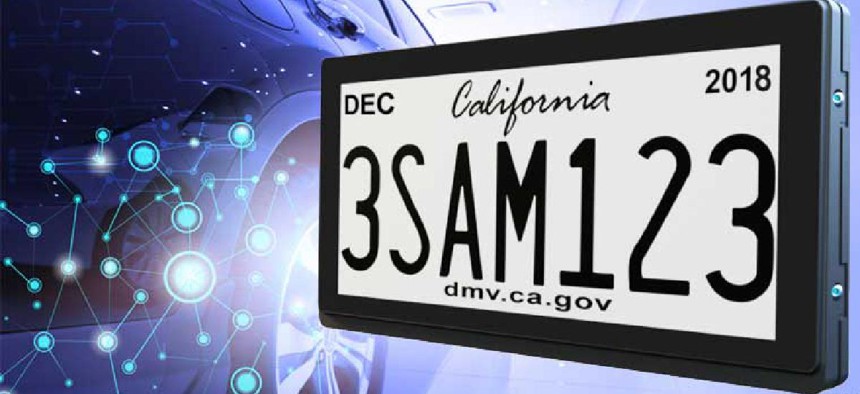Sacramento drives digital license plate test


Connecting state and local government leaders
The plates will provide fleet management data to the city, allow drivers to renew registrations online and even flash emergency messages.
When Sacramento, Calif., added Chevy Bolt all-electric cars to its fleet of about 2,000 city-owned vehicles, the tracking system it uses for vehicles with internal combustion engines wasn’t compatible with the Bolt's electric motor. But digital license plates are.
The city partnered with Reviver Auto, a digital license plate manufacturer, to provide its digital Rplate Pro for 24 Bolts. (The city is awaiting the arrival of 11 more.) Data the plates generate about mileage, for instance, are uploaded to Reviver’s cloud-based infrastructure and then made available to users.
“Being a government agency, obviously we need to know where our vehicles are,” said Mark Stevens, the city’s fleet manager. “We’ve had several vehicles stolen in the past, and because of the remote analytics in the systems we use, we were able to track those. Without this Reviver plate, we wouldn’t have been able to [track] these electric cars.”
If the power is cut to one of the city’s Bolts, the license plate alerts Reviver, which alerts city workers.
“Being that it is basically a global positioning system, it allows us to know where that vehicle is,” Stevens said. If anyone tries to steal the plate, it instantly goes into "license plate stolen" mode so thieves can't use it on another vehicle like they do with current steel license plates.
What’s more, future features of the plates would allow government agencies to push messages out to the plates, such as inclement weather warnings, traffic delay updates, and Amber and Silver alerts about missing people. The messages would not obscure the letter and number combination that makes up the plate, and they wouldn’t pop up or change until a vehicle has been stopped for at least six seconds.
Since May, the city has also been using the plates to track mileage on the Bolts to plan for preventive and other maintenance. The information comes to Stevens and his team via a monthly report that Reviver compiles from each car. Ultimately, he may pull the data himself, but the city is still ironing out the details of how the plates will communicate with the city, he said.
For non-electric cars, Sacramento uses two systems: the Zonar fleet management technology and RVA, or remote vehicle analytics. Both integrate into the city’s fleet software, so every time a vehicle is fueled, it automatically downloads the vehicle information, including mileage, into the fleet management system.
How Rplates work
The 6-by-12-inch Rplates use bistable electronic ink -- much like an Amazon Kindle -- and include a wireless communication system and rechargeable batteries. They communicate with transportation or motor vehicle departments over the air, enabling real-time communication for tasks such as registration renewal.
“The DMV will get the same money," but drivers won't have to visit the DMV and state workers won’t have to process the registrations manually, Reviver CEO Neville Boston said. “It makes it very easy because you don’t need stickers anymore. Once [a registration is] confirmed, you can update it over air.”
DMV.org estimates that California’s DMV could save up to $20 million annually on the postage needed to send out registration notices by using these plates.
Boston is working with cities on how to incorporate payment of tolls and other road usage fees into the platform to help government customers streamline processing and cover infrastructure costs.
To keep data secure, Reviver uses a cloud infrastructure and a virtual-private network encrypted with 256-bit keys. Using the platform is "akin to an online banking session,” Boston said. “The same kind of protocols that are in place for that are the protocols we use.”
Sacramento paid $299 per plate, compared to the $199 it pays for tracking technology on other vehicles, Stevens said, and about $20 per month to get the data. Although it’s too soon to say what the return on investment will be for the city, he said the digital plates are about more than saving money.
“When we can pull the data that we need, how do you assign a dollar value to that?” Stevens said.
For Louis Stewart, the city’s chief innovation officer, the plates are a stepping stone to future technology, such as autonomous cars. The city is working with Reviver to develop an application programming interface layer for communications that could geofence autonomous cars when they start appearing on the roads, he said.
“We’re talking about developing an API layer that would be similar to the iOS or the Google platform, where you just add apps on top of it,” Stewart said.
The Arizona Department of Transportation’s Motor Vehicle Division started testing Reviver’s plates about a year ago on 12 vehicles in the ADOT fleet to study potential applications, said Doug Nick, assistant communications director for customer outreach at ADOT.
“That question is still ongoing, really,” Nick said. “They do function as a license plate just fine. Beyond that, I don’t have enough data to share that gives us an idea of any other benefits to this point. They’re all still potential benefits that we’re studying.”
One of those could be an annual savings of almost $2 million by eliminating registration stickers, a state representative told ABC 15.
Other states also are preparing to use digital license plates. Prototypes will go to the Florida Department of Highway Safety and Motor Vehicles and the Texas Department of Public Safety by year’s end, and Reviver is in talks with another 10 states for 2019 projects, Boston said.
Editor's note: This article was changed July 2 to correct the reference to electronic ink.




